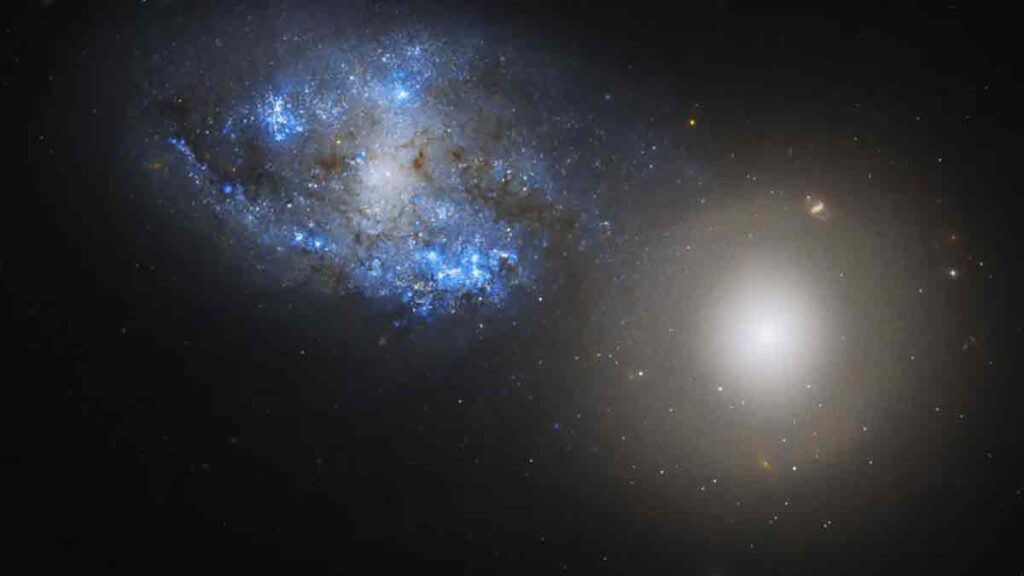
The NASA I was able to find out How space sounds. That's it, The US space agency Together with professional musicians, we managed to transform the scenes of the universe Hubble telescope Inside sounds like. One of these The sound of two galaxies interacting.
The sound of a pair of galaxies
last Sonification provided by National Aeronautics and Space Administration (NASA) is the data Arb 140, It shows a A pair of galaxies: The Galaxy Further left a spiral galaxy The band called NGC 275, and the star on the right a Lenticular galaxy Called NGC 274.
Scientists This image data was sonified by Assigns tone to the color of the image as a whole, with bluish light being the highest note and red light being the lowest. Hue is assigned to the brightness of resolved stars and background galaxies based on their apparent size, for example, larger objects appear to have less hue and smaller ones to have more hue. Bright light is strong throughout the film.
As stated therein NASAIn Galaxies Barred spirals are bands of stars running through the galaxy's central bulge, while lenticular galaxies are classified between elliptical and spiral galaxies and are named for their disk-like rim-like appearance. They usually do not contain much gas or dust and are mostly composed of old stars.
Other sounds from space
Through its website, the NASA provides some Sonifications This was achieved through images and data obtained by the Hubble Space Telescope. Some of them are:
This is Data sonification of the star V838 Monocerotis, oh V838 nShows two images Hubble Taken almost seven months apart. A pulse of light from the central star illuminates the clouds of dust and gas surrounding V838 Mon.
The star is located at the outer edge of the Milky Way, about 20,000 light-years away. In this sonification, scientists correlated brightness with pitch and loudness, and the surrounding stars were tuned to musical notes. The Sonification It radiates outward from the center of the first image of the star taken on May 20, 2002, and then disappears. Later, the Sonification It radiates outward from the center of the second image of the star taken on December 17, 2002.
RS Puppis is a bright star about 200 times the mass of the Sun and covered in dust that reflects the light of the stars. Located about 6,500 light-years away, the star brightens and dims rhythmically in a six-week cycle.
In this sonification, Scientists refer to image data as sound for a festive new experience RS puppies. Pitch is assigned based on the direction from the center and as the circle moves inward, points above the circle are assigned to higher notes and points below are assigned to lower notes.
The left light sounds louder in the left speaker and the right light sounds louder in the right speaker. In addition, the brightness of the image is assigned to a higher volume.
Bismis 24 It's an impressive one star cluster Located within Nebula NGC 6357, It is located about 8 thousand light years away. In this Sonification of the Hubble imageThe top-down scan maps the brightness to the size and inclination of both the stars and the nebula.
The stars are mapped to musical pitches played on a classical guitar, with brighter stars being louder and higher pitched, and the nebula using continuous frequencies, with brighter areas being louder and higher pitched. The red, green, and blue channels are assigned to the low, medium, and high frequency ranges, respectively.
To consult all NASA sonificationsEnter the YouTube channel NASA Goddard or to the site https://science.nasa.gov/mission/hubble/multimedia/sonifications/.
How does NASA receive the sound of space organs?
According to NASA, Image elements such as brightness and position are assigned tons and volumes. Although no sound can travel through space, Sonifications They provide a new way to experience and conceptualize data.
Los Sonifications Allow visitors including blind and visually impaired communities “Hear” astronomical images Explore your data.





